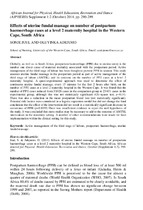Effects of uterine fundal massage on number of postpartum haemorrhage cases at a level 2 maternity hospital in the Western Cape, South Africa
Abstract
Globally, as well as in South Africa, postpartum haemorrhage (PPH) due to uterine atony is the number one direct cause of maternal mortality associated with the postpartum period. Active management of the third stage of labour has been thought to prevent PPH in women. This study assesses uterine fundal massage in the postpartum period as part of active management of the third stage of labour (AMTSL) and its outcome on the number of PPH cases at a level 2 maternity hospital. A quasi-experimental approach was used to determine the effect of continuous uterine fundal massage, every 15 minutes for the first 2 hours after birth, on the number of PPH cases at a level 2 maternity hospital in the Western Cape. It was found that the number of PPH cases reduced from 33/426 cases in the comparison group to 23/431 cases in the experimental group, although this was not statistically significant (Chi-square test, p=0.14). There was also a reduction in the mean postpartum blood loss (not statistically significant). Potential risk factors were considered in a logistic regression model but did not change the final conclusion that the effect of the intervention did not result in a statistically significant decrease in occurrence of PPH (p=0.1039).There was insufficient evidence to reject the null hypothesis of the study. It was concluded that more studies may be necessary to add to the outcome of AMTSL intervention in the maternity setting. A number of other recommendations were made for later implementation within the clinical setting for this study.

